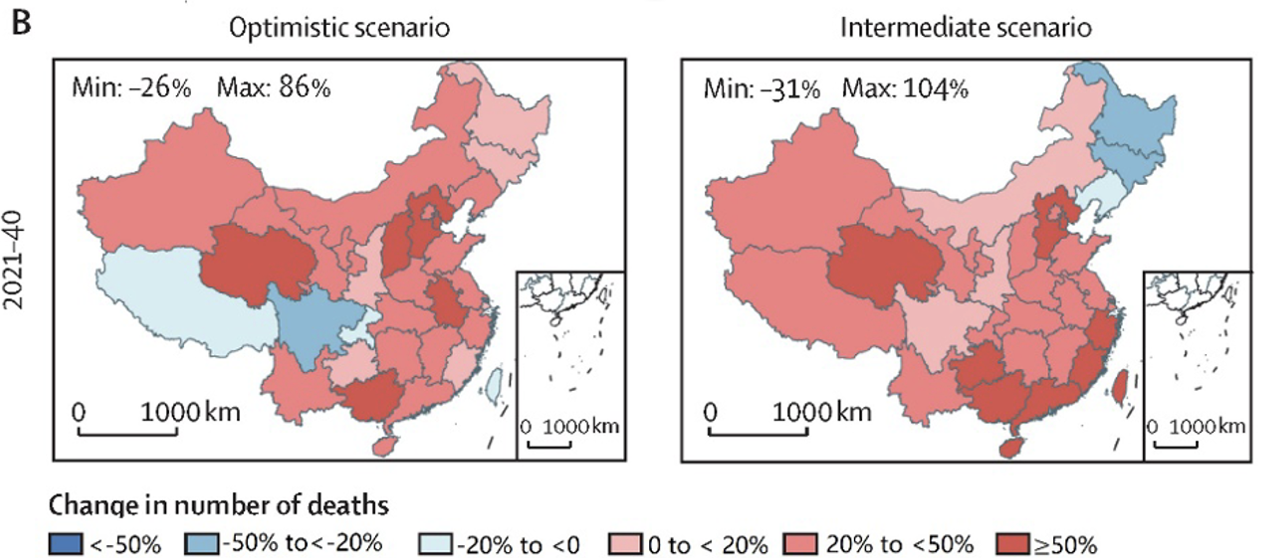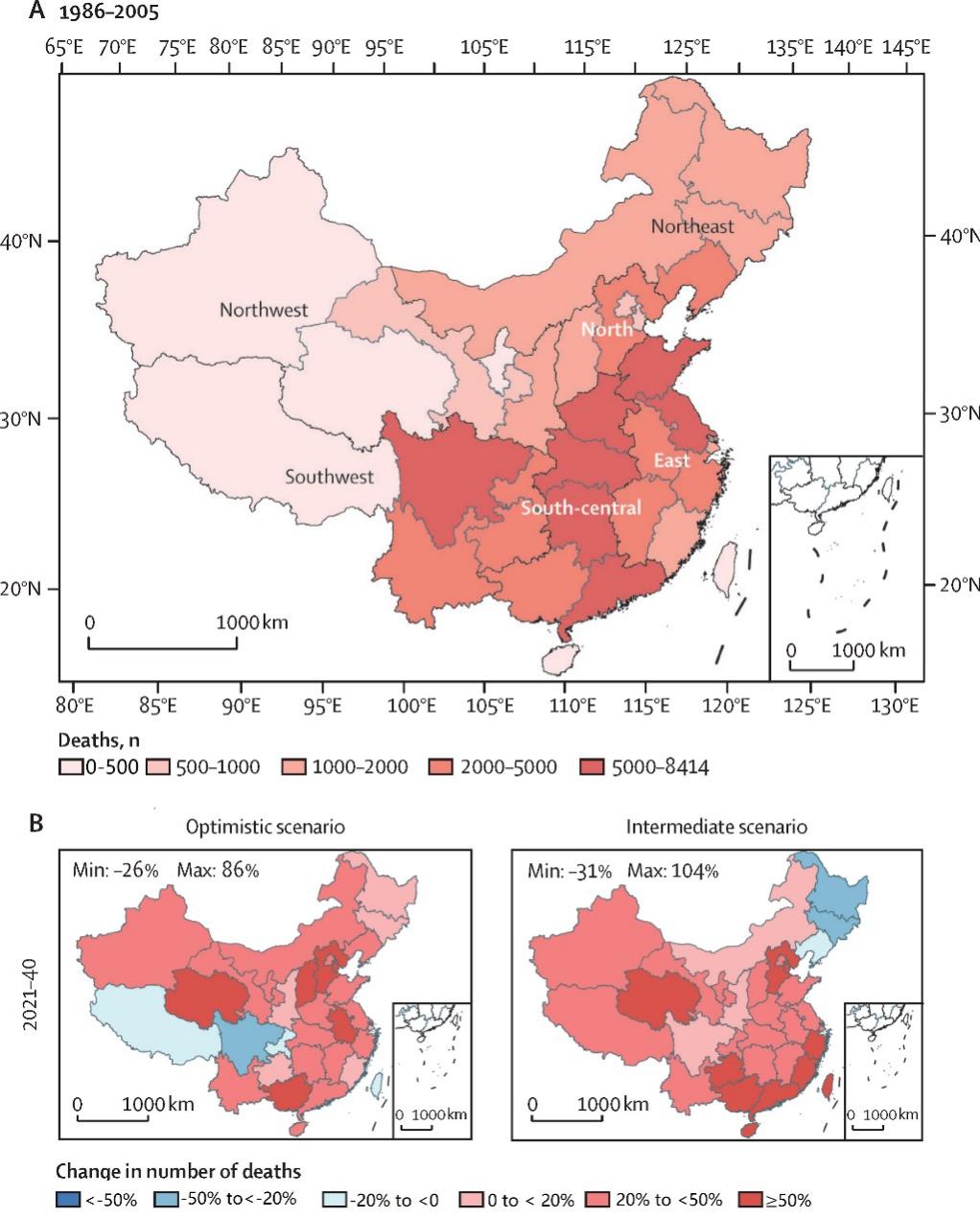A sophisticated model predicts that Chinese deaths linked to wildfire smoke will be higher than previous estimates.
A significant growth in the Chinese population’s exposure to wildfire smoke was tracked by researchers at Tsinghua University since 2021.1 Led by Yuqi Bai, the team found a 24.5% increase in the average annual exposure of people to wildfire air pollution in China for the period 2016–2020 compared to 2001–2005.

Map B shows the projected changes in all-cause deaths in China between 2021–2040 due to landscape fire-related PM2.5.
Bai’s team followed up in 2022 with detailed models that predict future wildfire-related deaths in China, both across time and by region. These models predict that the growth in wildfire mortality will peak in the near future. But they also predict that mortality linked to short-term exposure (i.e., a few days) to wildfire pollution in China is likely to exceed estimates by global models.
If low levels of carbon-emission control are implemented, China’s annual mean all-cause death attributable to fine particulate matter (PM2.5) pollution from wildfires is projected to increase by 37.38% in the period 2021–2040, compared to the period 1986–2005 period (see map).2
This is more deaths than predicted by previous models. The difference: Bai’s models employed 11 fire models instead of one. “Using multiple models helps cover more possibilities and uncertainties, making our projections more reliable,” Bai explains.
The models also used specialized equations designed specifically for fine particulate matter from wildfires rather than formulas for more general air pollution. PM2.5 particles from wildfires are often more harmful than PM2.5 from urban sources such as car exhaust, Bai explains. Being smaller, these particles more readily infiltrate the depths of the lungs and enter the bloodstream. This can trigger systemic inflammation and heighten the overall risk of death from multiple causes (most notably heart attacks, strokes and severe respiratory problems).

Yuqi Bai (in blue) and his team use drones to map wildfire risk in China.
Projections for protection
Bai’s work is part of a Lancet Countdown Asia Center’s initiative, which aims to understand the multidimensional health risks China faces due to climate change.
To help drive wildfire policy, his team’s study published in 2023 made predictions under different global-warming scenarios about wildfire related mortality up to 21003.
“Looking towards the future, the frequency of wildfires in China will probably increase as a consequence of climate change,” explains Bai. Capping the global temperature rise to within 2°C will significantly reduce the health burden caused by wildfires.
However, continuous implementation of rigorous policies to prevent and address wildfire smoke are also imperative, says Bai. The focus must shift from fire suppression to holistic fire management, he says. This approach involves fuel-reduction treatments to lessen wildfire size and intensity, along with reinforcing policies against risky practices, such as crop burning. Special attention, he adds, is needed in vulnerable regions like south-central China, east China, and the North China Plain, where the highest increases in fire-related mortality are anticipated (see map).

Map A shows the projected all-cause deaths due to landscape fire-related PM2.5 at a provincial level in China (1986–2005). Map B shows the projected changes in deaths (2021–2040) due to the same factors.
It will also mean updating and extending national plans, such as China’s National Forest Fire Prevention Plan and the National Grassland Fire Prevention Plan, says Bai.
“The nation’s substantial population renders it particularly vulnerable to wildfires, leading to the currently high annual deaths attributed to fire-related PM2.5,” says Bai. “A comprehensive strategy combining global climate action, targeted local policies, systematic planning, and a shift towards holistic fire management is vital to mitigate the risks.”
References
1. Cai, W., Zhang, C., Zhang, S., Ai, S., Bai, Y. et al. The 2021 China report of the Lancet Countdown on health and climate change: seizing the window of opportunity. The Lancet Public Health S2468266721002097 (2021) doi: 10.1016/S2468-2667(21)00209-7
2. Lou, S., Liu, Y., Bai, Y., Li, F., Lin, G. et al. Projections of mortality risk attributable to short-term exposure to landscape fire smoke in China, 2021–2100: a health impact assessment study. The Lancet Planetary Health 7, e841–e849 (2023) doi: 10.1016/S2542-5196(23)00192-4
3. Wu, Z., Hong, S.H., Keane, R.E., Zhu, Z. et al. Current and future patterns of forest fire occurrence in China. International Journal of Wildland Fire 29, 104–119 (2020) doi: 10.1071/WF19039
Editor: Guo Lili